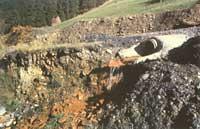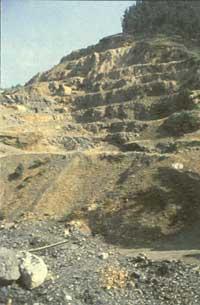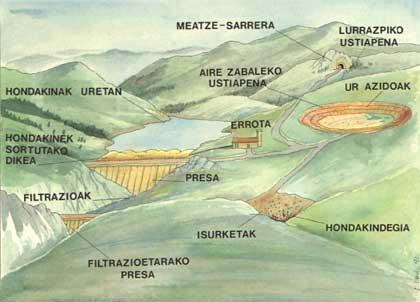Mines: environmental conditions
The use and use of metals has undoubtedly been one of the most influential discoveries in the development of humanity. The acquisition of hard and durable metal tools allowed to begin to cultivate the lands, thus giving the passage of hunter and collector societies to agriculture.

The first exploited minerals were those on the surface. The first were the open-pit farms. Until more elaborate exploitation techniques were mastered it was not possible to take advantage of underground minerals. Subsequently, galleries were opened in the basement and wounds with greater environmental impact were created.
Due to the exploitation of the mines, throughout history there are abundant spaces that have been clothed with huge residual summits or total degradation of the landscape. In the Spanish state there are examples of this type. Río Tinto, Sotrel and Tharsis de Huelva and the Medulas de León.
In Euskal Herria we also have such things. The Somorrostro iron farms and the Arditurri mining sites are a sample of the consequences of large-scale mining.

Impacts
The environmental effects of mining can be classified into four large groups:
- Deterioration of the landscape. The deposits are found, in most cases, in mountainous areas, in more or less inclined areas, and the first thing to do for their exploitation is to clean the land and the vegetation that covers them. Only thus have the necessary facilities been built. In addition, among the minerals extracted there are materials poor in metals (vaults) that are discarded. Consequently, huge landfills are generated without vegetation and without any stability. These characteristics that characterize these newly created menisques give rise to a large number of rotations.
We will remember the gold mines of the Roman era of Leon to see how extensive mining can damage the landscape. The ravines deposited there are an example of this. - Atmospheric and acoustic pollution and vibrations. Mining generates a lot of dust that is dispersed by the wind. In addition, machinery and blasts produce gas and sound.
 Arditurri. Water from the mine.
Arditurri. Water from the mine. - Water pollution. The procedures used for the separation of minerals from mixed rock result in discharges of water and mud contaminated with heavy metals. To this we must add the effect of rainwater that filters along the landfill, which can dissolve and transport toxic metals that may contain. All this water will be poured into the rivers and streams of the area, where the fish fauna of the area is extinct for many years.
- Hydrological condition. The clearing and the galleries that are carried out in the mining work divert the underground currents of water, offering new water and accumulating water. Once mining is completed, diseases are flooded and the water coming out of it is contaminated with metals.
The final effect of uncontrolled exploitation is usually severe deterioration of the environment, in some cases reaching desertification.

Rehabilitation

The rehabilitation of the contaminated mining area must start from a thorough study. This study allows to know what the affected area is, how pollutants are dispersed and what are the most affected aspects of the ecosystem.
Once the dispersion and influence of polluting compounds is known, the next step is to analyze how to prevent the release of the deposit or how to convert them into non-toxic substances.
Currently, the methods used to reduce the level of contamination from mining waste are the neutralization of effluents and the immobilization of heavy metals.
In the case of the landfill, the first layer of land (1 m thick) is used to encourage the growth of vegetation. This prevents erosion and transport of waste, while reducing the amount of water filtered through waste and making leaching water difficult to generate.

Water from the mine and leaching waters can be treated in conventional plants, that is, in plants that use the precipitation or ion exchange procedure. However, the current trend is to use low technology and low consumption methods. Among them, the creation of artificial marshes is the most used. In these swampy areas grow the reed ( Juncus effusus) and the leafy reed ( Typha latifolia). In it the acidity of the waters is neutralized and the metals remain in the organic matter of the sediments.
These methods, driven by new trends in geobiochemical engineering, are not only cheaper, but also retouch the landscape by eliminating mine wounds.
Acidic waters: How they are created
|






